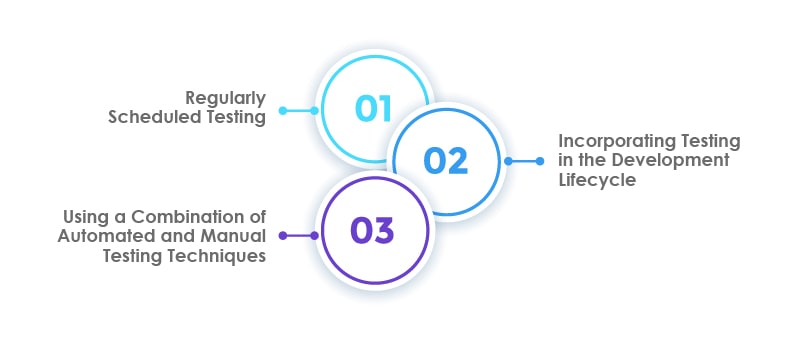Published: 23 Nov 2023
How Vulnerability Testing Can Protect Websites from Cyber Attacks?
Last Updated: 20 Dec 2023
- What is Vulnerability Testing for websites?
- Differentiating Vulnerability Testing, Penetration Testing, and Website Audits
- Benefits of Vulnerability Testing
- Common Vulnerabilities Often Detected
- Best Practices in Vulnerability Testing
- Selecting the Right Tools for Web Vulnerability Testing
- Conclusion
- How TestingXperts can help with Vulnerability Testing?
The digital business environment continues to evolve at a rapid pace, bringing both opportunities and challenges. According to data from the World Economic Forum, cyberattacks are one of the top global risks for digital transformation. As businesses increasingly shift online, websites have become potential targets for cybercriminals. These attacks are not only more frequent but also more sophisticated, making the task of securing websites even more crucial.
These growing threats highlight the importance of proactive measures to defend against potential breaches. A reactive strategy that depends on addressing cyber threats after they manifest often results in significant financial losses and a tarnished brand image. In such a landscape, vulnerability testing for websites stands out as an essential tool. By proactively identifying and addressing security gaps, businesses can protect their digital assets and maintain the trust of their stakeholders and customers.
What is Vulnerability Testing for websites?
Vulnerability testing is a systematic process to evaluate a system, in this context, a website, for any potential security gaps, weaknesses, or flaws that cybercriminals could exploit. The primary goal is identifying these vulnerabilities before hackers do, allowing businesses to take necessary steps to rectify them.
The importance of vulnerability testing cannot be ignored. With cyberattacks becoming more frequent and advanced, the chances of compromised websites increase. Vulnerability testing helps:
• By discovering weak points early so that businesses can prevent potential breaches.
• Customers and stakeholders feel more confident interacting with a secure website.
• Various industries with regular vulnerability assessments to meet compliance standards, ensuring data protection and privacy.
Types of Vulnerability Testing
Different digital assets and systems necessitate various approaches to vulnerability or penetration testing services. Here are the primary types:

Network-based Testing
Focuses on identifying vulnerabilities in a company’s network infrastructure. It can be external, evaluating vulnerabilities from outside the network, and internal, assessing potential threats from within.
Host-based Testing
Concentrates on the vulnerabilities of individual hosts or devices within an organization, such as servers and workstations.
Application Testing
Specifically targets software applications, examining them for flaws that could lead to unauthorized access or data breaches.
Wireless Network Testing: Evaluates the security of wireless networks, ensuring they are safeguarded against threats specific to wireless communication.
Differentiating Vulnerability Testing, Penetration Testing, and Website Audits

| Aspect |
Vulnerability Testing |
Penetration Testing
|
Website Audits
|
| Purpose |
Identifies potential vulnerabilities in a system or application. |
Simulates cyber-attacks to test a system’s security mechanisms. |
Comprehensive review of a website’s performance, security, user experience, and more. |
| Scope |
Focuses solely on discovering security flaws. |
Tests the exploitability of vulnerabilities and evaluates the overall security architect. |
Broad scope, reviewing everything from site structure to SEO, content, and security. |
| Methodology |
Uses automated tools and manual techniques to find vulnerabilities. |
Often starts after vulnerability testing, using tools and manual tactics to exploit found vulnerabilities. |
Uses automated tools and manual review to evaluate various segments of a website. |
| Frequency |
Regular intervals, especially after significant system or application updates. |
Typically conducted annually or after significant changes to the infrastructure. |
Can be periodic, especially for aspects like SEO, user experience, and content updates. |
| Outcome |
A list of potential security flaws with severity ratings. |
A detailed report of exploited vulnerabilities and potential damage. |
Comprehensive report detailing strengths, weaknesses, and recommendations for improvement. |
| Primary Goal |
Discover security weaknesses before cyber criminals do. |
Understand the real-world impact of potential breaches. |
Holistic improvement of the website across multiple domains. |
Benefits of Vulnerability Testing
In this digital-driven business environment, ensuring the security of online platforms is necessary. Vulnerability testing equips businesses with valuable insights to secure their online presence. By delving deep into the system’s architect, vulnerability testing highlights the areas of concern, enabling companies to build a robust and resilient digital presence. Let’s look into the specific advantages it offers:

Detecting Potential Weak Points
Vulnerability testing acts as a scanner that scans through every website component to highlight potential security flaws. Identifying these weak points offers businesses the first line of defense against cyberattacks. Before cyber criminals can exploit these vulnerabilities, businesses can identify and rectify them.
Comprehensive Assessment of Security Protocol
A thorough security strategy requires a clear understanding of the current parameters state. Vulnerability testing provides a comprehensive overview of a website’s security posture by evaluating the presence of vulnerabilities and their severity It evaluates the presence of vulnerabilities and their severity.
Prioritizing Remediation Efforts
While addressing all vulnerabilities is crucial, not all pose the same threat level. Some might be easily exploitable, leading to significant damage, while others might be less harmful. Vulnerability testing categorizes these flaws based on their potential impact, guiding businesses in prioritizing their remediation efforts. This ensures that the most critical vulnerabilities are addressed immediately, reducing the risk of severe breaches.
Common Vulnerabilities Often Detected
While well-known within the cybersecurity community, these common threats still find their way into numerous web platforms, posing significant risks. Recognizing and understanding these vulnerabilities is the first step towards protecting a website from cyberattacks. Let’s explore some of the most prevalent vulnerabilities professionals often detect during assessments:

Cross-Site Scripting (XSS)
XSS is a vulnerability where attackers inject malicious scripts into web pages viewed by unsuspecting users. These scripts, once executed, can steal user data, modify web content, or even redirect users to malicious sites. Given its potential impact, addressing XSS vulnerabilities is vital to preserving the integrity of a website and protecting its users.
SQL Injection
SQL injection involves attackers inserting or “injecting” malicious SQL code into a query. This can lead to unauthorized viewing of data, corrupting or deleting data, and, in some cases, can provide administrative rights to attackers. Since many websites rely on databases, protecting against SQL injections is paramount to safeguarding sensitive data.
Cross-Site Request Forgery (CSRF)
CSRF tricks the victim into executing unwanted actions on a web application where they’re currently authenticated. This could lead to unauthorized actions being performed without the user’s knowledge. By addressing CSRF vulnerabilities, businesses can prevent unauthorized changes and maintain the trust of their users.
Unsecured Direct Object References
This vulnerability arises when an application provides direct access to objects based on user input. Attackers can manipulate these references to access unauthorized data. Ensuring that proper authorization checks are in place can prevent this vulnerability from being exploited.
Best Practices in Vulnerability Testing
Effective vulnerability testing is not just about identifying potential weak points. It’s about maximizing the effectiveness of these tests to provide actionable insights and create a secure web environment. Adopting best practices ensures that vulnerability testing offers a comprehensive approach to web security. The key practices are as follows:

Regularly Scheduled Testing
Regularly scheduled vulnerability testing ensures that new additions or modifications to a website do not introduce fresh vulnerabilities. By committing to periodic assessments, businesses can remain ahead of potential threats and adapt to the dynamic landscape of cybersecurity.
Incorporating Testing in the Development Lifecycle
By incorporating vulnerability testing early in the development lifecycle, businesses can identify and address security concerns at their inception. This proactive approach mitigates risks and leads to cost savings, as rectifying vulnerabilities post-launch can be significantly more resource intensive.
Using a Combination of Automated and Manual Testing Techniques
While automated tools can swiftly scan and identify many vulnerabilities, they might miss context-specific threats or more nuanced security flaws. By seasoned professionals, manual testing facilitates automated scans by looking into potential weak points, providing a more comprehensive security assessment. A balanced combination of both techniques ensures thoroughness and accuracy in vulnerability detection.
Selecting the Right Tools for Web Vulnerability Testing
Every website is distinct, with its set of functionalities, technologies, and architectures. Before starting with tool selection, evaluating the website’s specific requirements is crucial. Consider the platform on which the site is built, the kind of data it handles, and the potential threats it might be exposed to. Additionally, the scale of the website, traffic patterns, and integration points should guide the choice of vulnerability testing tools.

Many vulnerability scanners and tools are available, each with strengths and focus areas. Some popular options include:
OWASP ZAP
An open-source tool perfect for pen-testers and developers. Not only does it offer automated scanners, but it also provides features like passive scanning and spidering. Its community-driven model ensures it stays up-to-date with the latest threat intelligence and vulnerabilities.
Burp Suite
Renowned for its web application security testing capabilities, it delivers a comprehensive scanning solution. Its intuitive user interface and tools like Intruder and Repeater allow for detailed and manual testing, providing deep insights into potential security flaws.
Nessus
This tool is known for its precision and extensive plugin library. Its ability to perform high-speed asset discovery and configuration auditing sets it apart, making it a favoured choice for organizations of all sizes.
Acunetix
Specifically designed for web application testing, Acunetix stands out with its swift scanning engine. With a focus on modern single-page applications and the ability to detect over 4500 web vulnerabilities, it’s a good tool in any security professional’s inventory.
Conclusion
In the fast-changing world of cybersecurity, staying alert is crucial. Vulnerability testing is about finding risks and strengthening your websites against threats. Equip yourselves with the best practices by understanding your web infrastructure’s unique challenges and adapting to emerging risks. With the right strategies, tools, and a proactive approach, you can stay ahead of cybercriminals, ensuring your websites remain reliable and trustworthy.
How TestingXperts can help with Vulnerability Testing?
TestingXperts provides various vulnerability testing services honed by years of experience. Our dedicated team collaborates closely with clients, ensuring each testing process aligns perfectly with the unique security requirements of their digital platforms. With TestingXperts, it’s not just about finding vulnerabilities. It’s about implementing a strategy to ensure ongoing digital safety.

• We understand every digital platform has unique requirements. Our penetration testing services are tailored to match your specific web infrastructure and business needs.
• We employ the latest vulnerability detection tools, ensuring thorough and accurate testing results.
• Our team, comprising QA cybersecurity professionals, brings knowledge to every project.
• Receive detailed reports highlighting potential risks and actionable steps for mitigation, ensuring you’re well-equipped to enhance security.
• We have our in-house accelerators, such as Tx-Pears, to accelerate the testing process and enhance efficiency without compromising security.
To know more about our services, contact our experts now.